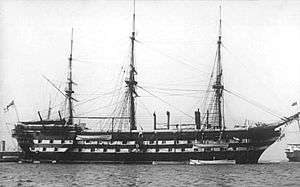HMS Boscawen (1844)
 HMS Boscawen, 1904 | |
| History | |
|---|---|
| Name: | HMS Boscawen |
| Ordered: | 11 May 1817 |
| Builder: | Woolwich Dockyard |
| Laid down: | January 1826 |
| Launched: | 3 April 1844 |
| Renamed: | Wellesley 1873 |
| Fate: |
|
| General characteristics [1] | |
| Class and type: | 70-gun third rate ship of the line |
| Tons burthen: | 2048 tons (2080.9 tonnes) |
| Length: | 187 ft 4 1⁄2 in (57.1 m) (gundeck) |
| Beam: | 50 ft 9 in (15.47 m) |
| Depth of hold: | 21 ft 6 in (6.55 m) |
| Propulsion: | Sails |
| Sail plan: | Full rigged ship |
| Armament: |
|
HMS Boscawan was a 70-gun third rate ship of the line of the Royal Navy, launched on 3 April 1844 at Woolwich Dockyard. She was originally ordered and begun as a 74-gun ship, but an Admiralty order dated 3 March 1834 required that she be reworked to Sir William Symonds' design.[1] She was named for Admiral Edward Boscawen.
In 1873, Boscawen replaced Wellesley – the former HMS Cornwall – as the training ship at Wellesley Nautical School and was herself renamed Wellesley.[2]
On the afternoon of 11 March 1914, Wellesley was destroyed by fire and sank at her moorings on the River Tyne at North Shields. A total loss, she was broken up later in 1914.[1][2]
Notes
References
- Lavery, Brian (2003) The Ship of the Line - Volume 1: The development of the battlefleet 1650-1850. Conway Maritime Press. ISBN 0-85177-252-8.
External links
Wellesley burning at her moorings in the River Tyne at North Shields on the afternoon of 11 March 1914, photographed from South Shields.
The wreck of Wellesley in 1914.
This article is issued from
Wikipedia.
The text is licensed under Creative Commons - Attribution - Sharealike.
Additional terms may apply for the media files.